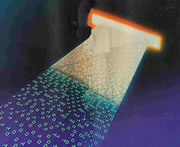| |

Banks and billers face a muddled environment of electronic and paper-based processes.
The latest technology merges mixed payments and streamlines conventional transactions.
|
|
|
|
Coping With Mixed Payments
Coping With Mixed Payments
EBPP will eventually provide a
huge leap in efficiency-over traditional remittance processing. But online payment
vendors are a long way from providing direct electronic links to every payee.
Even the largest online payment brokers still send out many paper checks. CheckFree,
the 100 pound gorilla on on-line payments, estimates that 40 percent of its
payments are made on paper. This mixture of paper and electronic payments can
create real headaches for lockbox operations and remittance processing vendors.
"The problem is that the
paper stubs shipped out by online payment brokers don't look anything like stubs
shipped out with the original paper bills," notes Jeff Vetterick, vice
president of marketing at Advanced Financial Solutions (AFS), Oklahoma City,
OK, a major remittance processing technology provider.
It wouldn't be so bad if each
check was applied to a single bill and was accompanied by a single stub in a
machine-readable format. "But it's not realistic to expect the CheckFrees
of the world to send out 10,000 separate checks to any one payee each month,"
says Vetterick.
Instead, online payment consolidators
cut postage and processing costs by batching payments; a single check arrives
along with a list of all transactions covered by that check. These lists almost
always need to be keyed in manually. From the remittance processor's perspective,
it's a nightmare.
"The problem is compounded
by the fact that every online payment consolidator uses a different format for
the payment list - typically formatted on 8-1/2-by-11 sheets of paper or on
long sheets of greenbar," says Vetterick. "None of this stuff can
be handled normally through the usual reader/sorters and other tyes of high-speed
transports. Unless new processes can be put into place, all of it gets handled
as an exception."
Advanced Financial Solutions solves
this problem by handing it over to a module they dub "DREAM" (Dynamic
Reject Auto-Correction Module). The software was originally designed to automate
MICR (magnetic ink character recognition) rejects. The software uses
ICR (intelligent character recognition) technology to take a second look
at the MICR line at the bottom of checks that could not be recognized magnetically.
AFS's Scott Image Associates unit, in Sanford, NC, has tested the software and
reports that it automated as much as 80 percent of previously rejected items.
AFS customers are now using this
software to handle checks and lists coming from online payment brokers, including
CheckFree. "It's a little different workstream," notes Vetterick.
"Since DREAM can automatically read the MICR line off the check,
both the check-and-list can be scanned on the same scanner at the same
time, maintaining transactional integrity."
According to Vetterick, "it's
20 times more efficient" to handle both at the same time than to separate
the paper paths and put them together later on.
Wausau Financial Systems, a payment
automation systems provider in Mosinee, WI, has addressed the electronic payment
check-and-list problem by adding full-page OCR (optical character recognition)
to its ImageRPS remittance processing solution. The upgrade also addresses money
orders, travelers checks and other items that usually demand manual keying.
"The recognition software enhancements provided with ImageRPS will transform
how exception item data gets captured in a remittance environment," says
Mike Tallitsch, Wausau's product manager for remittance processing. "From
multi-page, check-and-list transactions to money orders from a convenience store
or any other provider, [exception items are] now easily automated for significant
labor savings."
Next-> Streamlining
Conventional Payments
|



